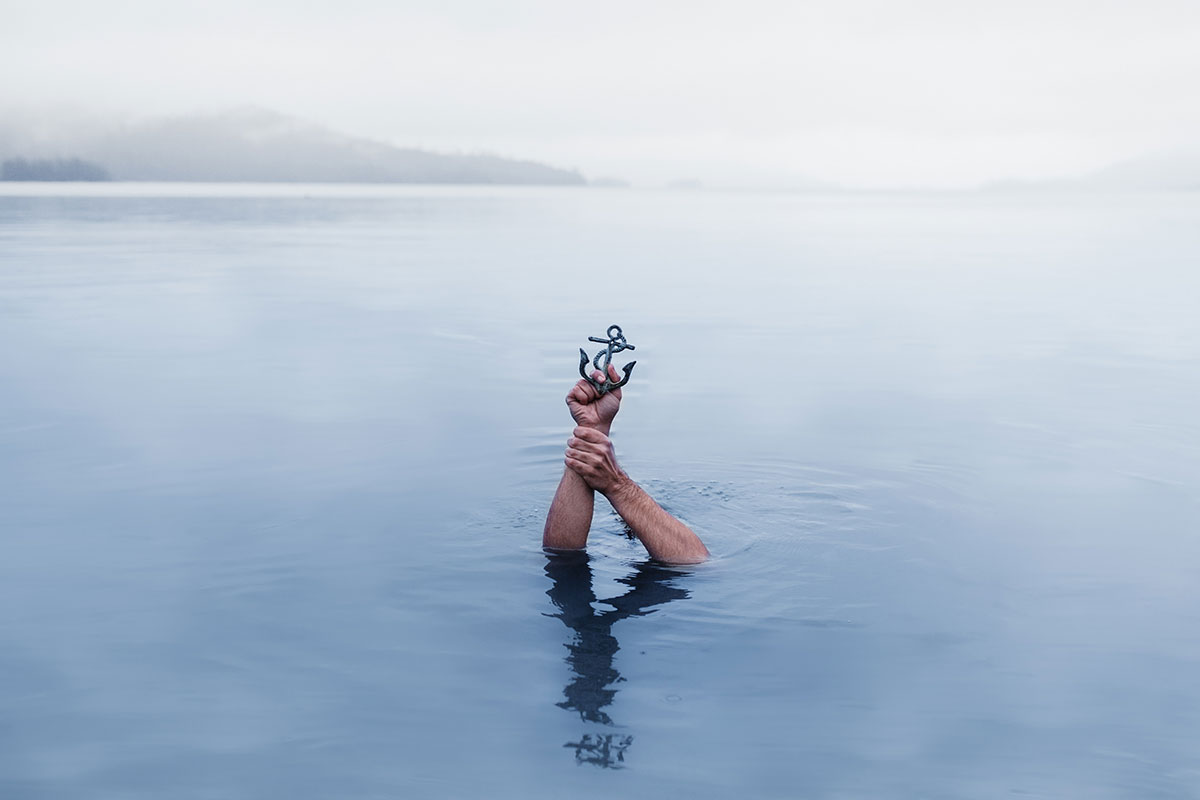How to ANCHOR:
reach the chosen point checking that there is sufficient space around it in a radius equal to the length of the calume (length of the rope) that you want to release, so as to allow the possible rotation of the boat in case of changes in the direction of the wind;
having done this with the boat stationary and the bow facing the direction of the wind, let the anchor slide until it touches the bottom, then slowly move back, letting the chain (or rope) slide, until the desired length is extended and at this point the descent is blocked and the acceleration is accelerated in reverse to allow the anchor to have a good grip on the bottom; if the anchor moves we will add more rope (or chain), until the movement stops.
When the seabed is not good holding or when we want to keep the boat oriented also using ropes fixed to the ground, we can resort to using more anchors.
In the case of poor seabed or strong wind forecast, we can join two anchors at a certain distance, positioning them on the bottom in sequence: this mooring is defined as hanging anchors.
If, however, we want to keep a fixed position or we know that the wind will blow strongly and from a certain direction, we can place the two separate anchors at an angle of approximately 40/60° between them, the boat will therefore not be able to rotate freely, but will be constrained to a position between the two anchors.
It is important to keep the angle between the two anchors within these limits, if lower the chains could get stuck together, if higher the combined effect of the two moorings will not be had.
CONSIDERATIONS TO REMEMBER WHEN YOU DECIDE TO FUND:
- Seabed depth
- Type of backdrop
- Shelter from the waves
- Presence of current and/or tide
- Presence of other boats
- Weather forecast (possible changes in wind direction)
- GOOD TIPS: Sand, thick mud and slime
- MIDDLE LANDS: soft mud (tends to give way), rock
- BAD HOLDERS: algae (the anchor tends to tear them and lose its grip), corals, pebbles
The anchor aground
The anchor that refuses to rise is a problem that occurs with a certain periodicity, knowing the tricks to solve it is essential.
In a normal situation, the first concern should be to proceed slowly, helping ourselves with the engine so as not to excessively stress the winch.
Proceed in small steps forward until you arrive perpendicular to the anchor, thus eliminating the tension of the chain and allowing the windlass to pick it up without any difficulty.
In this regard, you will have to pay attention not only to the chain that is thrown into the water from the bridge, but also to the one that is deposited from the anchor winch in the cockpit.
In fact, if this is not deep enough, the risk is that the chain will form a mound in the locker and above all above it, ending up reaching under the winch.
At this point, when the chain is immediately under the gypsy, it will begin to resist, blocking the winch or causing the chain to jump.
If, however, you have a manual winch it will be convenient to recover the entire chain by hand and use it only to send the anchor from the bottom.
In the absence of aids it will be necessary to position yourself well seated and supported on the bow and, with the help of the engine’s power, slowly raise the anchor.
In this case it is very important not to put strain on your back, but to leverage your legs to avoid risking muscle tears.
In some cases, for example on rocky seabeds, it may happen that the anchor gets stuck:
to free it you will go beyond the anchor point keeping the cable in traction, thus trying to make it turn and lose its grip.
A preventive method is the use of the grippile, a line with a floating buoy fixed to the diamond of the anchor, which allows it to be recovered in reverse.
The Anchor Signals:
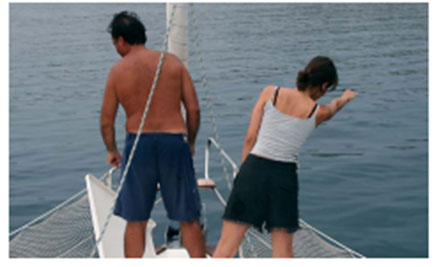
Open Hand – Forward Arm: “you can move forward, the anchor is on axis”
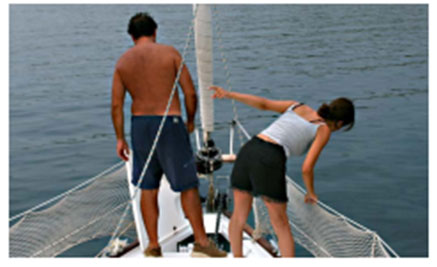
Open Hand and Left Arm: “the anchor is on your left, move slowly to the left”
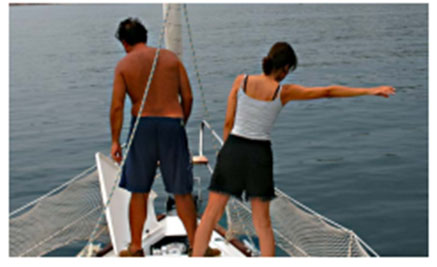
Open Hand and Right Arm: “the anchor is on your right, tack slowly to starboard”
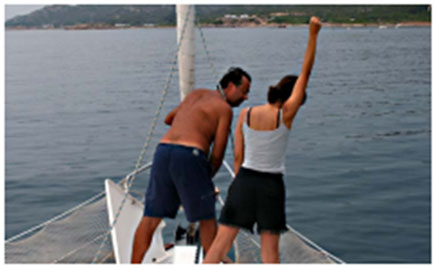
Closed Fist, Raised Arm: The chain or anchor is under the boat, “put it in neutral”
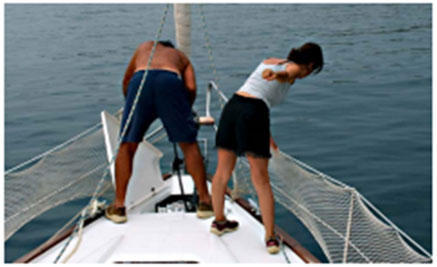
(rarely used)
Closed Fist, Arm Back: “Come back and stop the boat”
Watch out for the other chains at the bottom
When we have to moor in a crowded port it is essential to carefully look at the other anchors and carefully look for alignment in one’s place.
How to proceed?
Having positioned the bow on the exact point where the anchor must drop, it is necessary to stop for a moment, wind permitting, and lower the chain until it touches the bottom.
Only at that point can we step back, sure that the anchor is on the axis of our mooring.
Releasing the anchor without letting it sink to the seabed is essential when you are sure you are on other people’s chains. This maneuver avoids all the problems arising from cables, nets and submerged dead bodies which are always found in ports.
If the alignment in front of the mooring fails and the chain lands on those of other boats, measures must be taken immediately and the anchor recovered.
If we get this operation wrong we will end up with a bunch of twisted chains and many loose anchors.
The trick then is to exit as you entered.
The chain must never be pulled: if this happens, there is a risk that the anchor will blow and take with it the chains arranged on the seabed.
Still Trapped by more chains
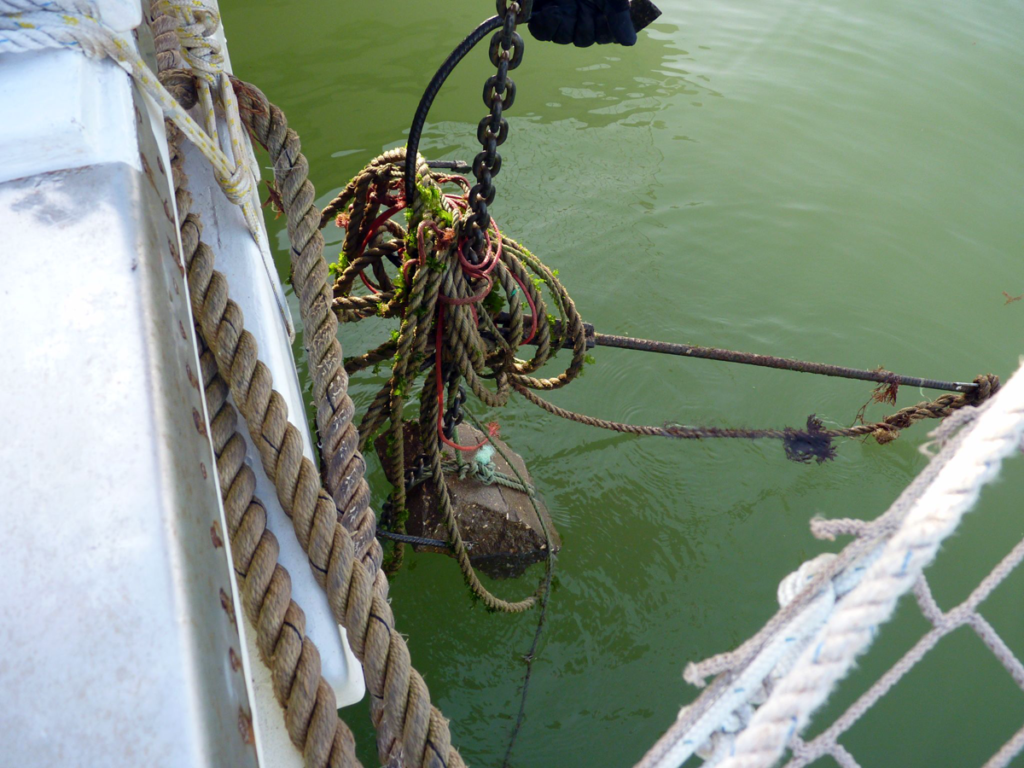
When we are moored in the harbor it can happen that others accidentally put their anchor on ours.
If there is no one on board the other boat to lend a hand, you will have to fend for yourself. You must leave your mooring very slowly and try to place the boat on the vertical of the chain.
While this is being pulled up by the winch, the anchorman will feel the vibrations (it means that the other chain is slipping on ours).
It is unlikely that the anchor will be able to reach the surface of the water because it is held down by the chain above it but it generally arrives close enough to the surface to be able to pass a double rope line under the chain that imprisons it.
Once the twisted pair is brought on board, it is secured to a cleat. At this point the other boat’s chain is hanging from our rope.
Now you lower your anchor for a couple of meters which, without the weight of the chain on top, will be able to swing and free itself.
After having brought the anchor back on board, the twisted pair is untied and the chain that caused us so much pain will sink again and we will finally be able to leave the port.
The Half Moon
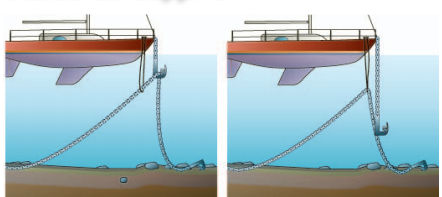
The anchor hook, or crescent, a name deriving from its shape, is a metal tool equipped with two ropes: a main one which is used to lower and hoist the anchor, and a secondary one, which is used to ‘turn’ it.
Well, this tool allows us to do what we have seen above, i.e. to free our chain from another that has settled on it more quickly, without having to make do with boat hooks and makeshift ropes, and above all even when the The intersection between the two chains remains well below the water’s edge.
How does it work?
- It must be lowered with the hook facing downwards, keeping only the main line under tension.
- At this point, by pulling the closing rope, the ring will rotate and hook the chain of the other boat.
- Once the rope that holds it has been tightened, the anchor is lowered, which without any obstacles holding it back, will be made to swing out of the triangle of the chain that imprisoned it.
- Once the operation is finished, rotate the hook again which will free the chain which will return to the bottom.
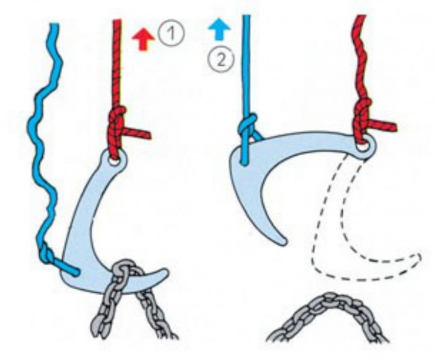
The crescent moon is not yet a perfect tool because, when you need to free the chain, sometimes it hooks onto it, other times, under the weight of the chain, it is unable to rotate. However, it remains a valuable tool to keep on board.
EMERGENCY: abandon anchor
It may happen that you are moored in a crowded roadstead and suddenly be hit by a gust of wind that causes several boats anchored near you to lose their grip. The only option is to get away as soon as possible.
But how can you recover the anchor quickly in a situation where grounding is practically guaranteed?
Salvation lies in letting go of the anchor:
- Take a fender (better if it has the name of the boat written on it) and a line that is a little longer than the depth of the water.
- Place the rope between the chain and the fender anywhere on the chain and cut the binding with a knife. At that point the chain is free and the whole thing falls into the water.
- When the situation is calmer and easier you can return to recover what you left.

